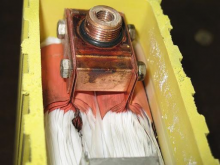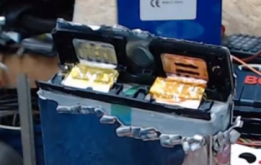I’m interested in hearing from anyone who has accidentally pierced through the aluminum bottom of a terminal on an EVE 280Ah cell: what happens and how do you know the worst has befallen?
It’s probably a false alarm but I may just have pierced the bottom of one of my terminals and don’t know how to confirm the worst or prove I’m still OK.
I’ve been gluing stainless grubscrews into my 280Ah cells and my process involves:
1/ characterizing number of turns to bottoming ‘dry’ and noting that for each terminal (big range so, with maximum of 5-3/4 turns and minimum of 4-5/8ths turns).
2/ Applying some JB Weld into the bottom of the terminal and some more on the cupped end of the grubscrew and then starting to thread the grubscrew.
3/ Once the grubscrew bottoms into the liquid JB Weld, finger tighten with an Allen Head wrench until JB Weld begins oozing out of the thread at the terminal surface (typically tighten ~1/8th turn every minute or so), keeping track of number of ‘wet’ rotations versus the rotations to bottoming dry noted earlier.
4/ Continue applying turns/pressure slowly by hand until you hit the number of turns to bottom (at which point the grubscrew should be fully threaded to the bottom of the terminal).
It’s all been working out well and I believe I can ‘feel’ when the grubscrew bottoms and I am no longer just applying some incremental pressure to force some incremental volume of JB Weld to ooze out at the top, but I just had a strange result with one terminal;
One of my deepest terminals at 5-1/2 turns still felt soft when I hit that point. So I kept gently applying pressure at ~1 minute intervals all the way until an additional 1/8th turn at which point I stopped (even though I felt like I could have threaded further.
Probably I made a mistake when I counted the turns to bottom the grubscrew dry, or a mistake when I noted those number of turns, or I lost track of the number of turns when I began threading with JB Weld.
But the torque required to get the JB Weld to ooze out of the top is not nothing - I believe it would easily pierce a layer of aluminum foil from the pressure/torque involved.
And I’ve seen all the warnings about how important it is to back screws off after bottoming because it is so easy to pierce the thin aluminum bottom of the terminal.
So on the off-chance I’ve ruined thus terminal (or possibly all of the terminals I’ve already JB Welded, what happens when you pierce through the bottom of a terminal and how can you test for it?
It’s probably a false alarm but I may just have pierced the bottom of one of my terminals and don’t know how to confirm the worst or prove I’m still OK.
I’ve been gluing stainless grubscrews into my 280Ah cells and my process involves:
1/ characterizing number of turns to bottoming ‘dry’ and noting that for each terminal (big range so, with maximum of 5-3/4 turns and minimum of 4-5/8ths turns).
2/ Applying some JB Weld into the bottom of the terminal and some more on the cupped end of the grubscrew and then starting to thread the grubscrew.
3/ Once the grubscrew bottoms into the liquid JB Weld, finger tighten with an Allen Head wrench until JB Weld begins oozing out of the thread at the terminal surface (typically tighten ~1/8th turn every minute or so), keeping track of number of ‘wet’ rotations versus the rotations to bottoming dry noted earlier.
4/ Continue applying turns/pressure slowly by hand until you hit the number of turns to bottom (at which point the grubscrew should be fully threaded to the bottom of the terminal).
It’s all been working out well and I believe I can ‘feel’ when the grubscrew bottoms and I am no longer just applying some incremental pressure to force some incremental volume of JB Weld to ooze out at the top, but I just had a strange result with one terminal;
One of my deepest terminals at 5-1/2 turns still felt soft when I hit that point. So I kept gently applying pressure at ~1 minute intervals all the way until an additional 1/8th turn at which point I stopped (even though I felt like I could have threaded further.
Probably I made a mistake when I counted the turns to bottom the grubscrew dry, or a mistake when I noted those number of turns, or I lost track of the number of turns when I began threading with JB Weld.
But the torque required to get the JB Weld to ooze out of the top is not nothing - I believe it would easily pierce a layer of aluminum foil from the pressure/torque involved.
And I’ve seen all the warnings about how important it is to back screws off after bottoming because it is so easy to pierce the thin aluminum bottom of the terminal.
So on the off-chance I’ve ruined thus terminal (or possibly all of the terminals I’ve already JB Welded, what happens when you pierce through the bottom of a terminal and how can you test for it?





